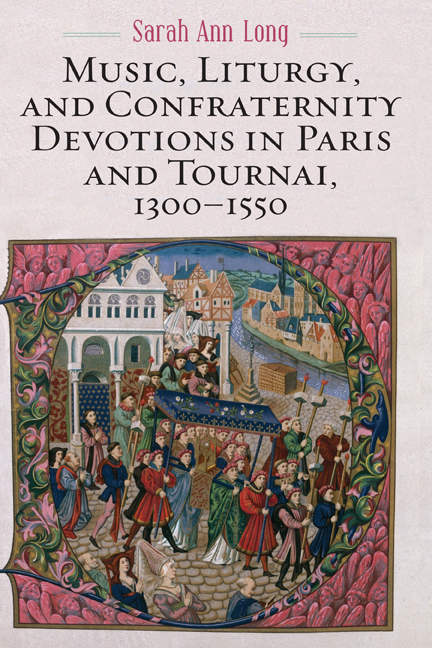Book contents
- Frontmatter
- Dedication
- Contents
- List of Illustrations
- Acknowledgments
- List of Abbreviations
- Editorial Procedures for Foreign Languages and Music Examples
- Note on Online Material
- Introduction
- 1 Confraternities and Popular Devotions to St. Barbara in Tournai
- 2 Relic Translation and Healing in Liturgies for St. Catherine and St. Nicholas in Paris
- 3 Historical Narratives and the Importance of Place in Masses for St. Sebastian
- 4 Compositional Practice, Networks, and the Dissemination of the Mass Ordinary in Confraternity Sources
- 5 The Role of the Parisian Book Production Community in the Perpetuation of Popular Devotions
- Conclusion
- Appendix 1 Sources
- Appendix 2 Inventories of Sources from Tournai
- Appendix 3 Scribal Hands and Gatherings in the Tournai Notary Confraternity Manuscripts
- Notes
- Bibliography
- Index of Chant and Polyphonic Compositions
- Index of Early Printed Liturgical Books
- Index of Manuscripts
- General Index
- Frontmatter
- Dedication
- Contents
- List of Illustrations
- Acknowledgments
- List of Abbreviations
- Editorial Procedures for Foreign Languages and Music Examples
- Note on Online Material
- Introduction
- 1 Confraternities and Popular Devotions to St. Barbara in Tournai
- 2 Relic Translation and Healing in Liturgies for St. Catherine and St. Nicholas in Paris
- 3 Historical Narratives and the Importance of Place in Masses for St. Sebastian
- 4 Compositional Practice, Networks, and the Dissemination of the Mass Ordinary in Confraternity Sources
- 5 The Role of the Parisian Book Production Community in the Perpetuation of Popular Devotions
- Conclusion
- Appendix 1 Sources
- Appendix 2 Inventories of Sources from Tournai
- Appendix 3 Scribal Hands and Gatherings in the Tournai Notary Confraternity Manuscripts
- Notes
- Bibliography
- Index of Chant and Polyphonic Compositions
- Index of Early Printed Liturgical Books
- Index of Manuscripts
- General Index
Summary
In the introduction to this book, I broadly explored how the movement of individuals (clerics and the laity) through different physical and social spaces could be related to the circulation of popular devotional practices cultivated by confraternities. In many cases there are no documents or confraternity registers recording the inner workings of these organizations, or informa-tion about those who were paid to compile and perform their services. Due to these limitations, I have relied on the contents of their existing liturgical books to investigate how the religious practices of these communities developed. As a result of my focus on the musical and textual contents of these sources, I have demonstrated how decentralized religious and spiritual authority was during the time period under study. As individuals, confraternity members were people who worked as merchants and artisans, clerics, and students. As communities, they had the power to develop their own corporate identities. I do not mean to imply that the laity directly challenged ecclesiastical authority. Instead, it is evident that lay authority and ecclesiastical authority were two different things, and that popular devotions, such as those promoted by confraternities, occupied a different space altogether from that of larger ecclesiastical and monastic institutions.
Confraternity liturgies were created and mediated by individuals and communities and were heavily influenced by contact between different networks. The various types of interactions between these entities could have been responsible for the dissemination of religious ideas, and particularly in times of plague, widespread beliefs concerning the healing attributes of certain saints. Those most commonly revered at the time were the fourteen holy helpers, which in northern France included St. Barbara, St. Catherine, and St. Nicholas. The popular devotional practices in this study did not travel in direct, easily traceable lines, but instead through constellations of individuals and communities, all of which were marked by movement—physical, social, and spiritual—resulting in the formation of different identities, with music playing a central role. While my interest has been northern France, looking at these types of movement would be a useful tool for investigations into other geographical areas further north in the Low Countries, east in the Hapsburg lands, and south in Italy. Below, I recap some of the examples from the present work that illustrate each type of movement.
- Type
- Chapter
- Information
- Publisher: Boydell & BrewerPrint publication year: 2021



